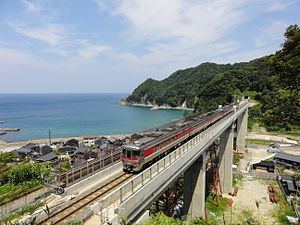Native name 山陰本線 Stations 159 Operator(s) JR WestJR Freight | Opened 1897 | |
 | ||
Terminis Shimonoseki Station, Kyōto Station | ||
San in main line and yumigahama beach yonago
The Sanin Main Line (山陰本線, San'in-honsen) is a railway line in western Japan, which connects Kyoto and Shimonoseki, Yamaguchi, operated by West Japan Railway Company (JR West). It is the major railway line of the San'in region, approximately paralleling the Japan Sea, crossing Kyoto, Hyōgo, Tottori, Shimane, and Yamaguchi prefectures. The main portion from Kyoto to Hatabu is the longest single continuous railway line in Japan at 673.8 km, although no regularly scheduled train operates over the entire line.
Contents
- San in main line and yumigahama beach yonago
- On board jr 126 aqua liner on the san in main line
- Basic data
- From Kyoto to Sonobe Sagano Line
- From Sonobe to Tottori
- From Tottori to Masuda
- History
- Double tracking
- Electrification
- Former connecting lines
- References
The section between Kyoto and Sonobe, connecting Kyoto and its northern suburbs, is a part of JR West's Urban Network and is nicknamed the Sagano Line.
On board jr 126 aqua liner on the san in main line
Basic data
From Kyoto to Sonobe (Sagano Line)
From Sonobe to Tottori
Rapid trains are operated as local trains and stop at every station between Sonobe and Fukuchiyama.
From Tottori to Masuda
History
The line was built by three different private companies, which were subsequently nationalised and connected by the Japanese Government Railway (JGR). The Kyoto Railway opened the section to Sonobe between 1897 and 1899. The Bantsuru Railway opened the Ayabe to Fukuchiyama section (as part of the current Maizuru Line) in 1904. Both companies were nationalised in 1907.
The first section opened by the JGR was between Yonago and Mikuriya in 1902, and the line was then progressively extended eastward, reaching Tottori in 1907 and Iwami in 1908, the same year the current Bantan Line opened to Wadayama and Yoka. Construction of that line continued westward, and the two lines were connected in 1912. In the meantime, the Sonobe to Ayabe section was opened in 1910, and the Fukuchiyama to Wadayama section the following year. In addition, construction from Yonago progressed westward, opening to Matsue in 1908 and Izumoshi in 1910, resulting in the a 385 km continuous line upon the 1912 connection mentioned above. At the western end, the Choshu Railway opened the Hatabu to Kogushi section in 1914.
From Izumoshi, construction continued progressively westward, opening to Masuda in 1923, and to Todakobama in 1925, the year that the Choshu Railway was nationalised and the Kogushi to Takibe section opened, with construction then continuing from both directions until the two sections were connected in 1933, completing the current line.
Double-tracking
The Yonago to Hoki-Daisen section was double-tracked between 1962 and 1966, with the Ayabe to Fukuchiyama section double-tracked in between 1968 and 1969, and the Tamatsukuri-Onsen to Kimachi section in 1970. The Matsue to Higashi-Matsue section was double-tracked in 1979, and the Yonago to Yasugi section in 1980. The original Saga-Arashiyama to Umahori section was built on the banks of the Hozugawa in a narrow gorge. A new double-track alignment was opened in 1989, and the original alignment became the Sagano Scenic Railway. Further double-tracking occurred in stages, with the entire Kyoto to Sonobe section double-tracked by 2010.
Electrification
The Hoki-Daisen to Izumoshi section was electrified in 1982 in conjunction with the electrification of the Hakubi Line. The Fukuchiyama to Kinosaki section was electrified in 1986 in conjunction with the electrification of the Fukuchiyama Line. The Sonobe to Fukuchiyama section was electrified between 1985 and 1986, and the Kyoto to Sonobe section in 1990.
